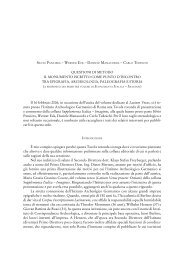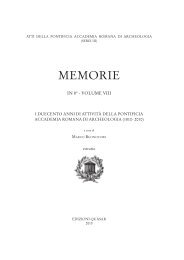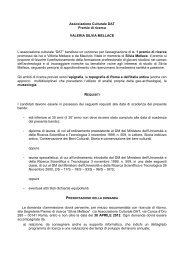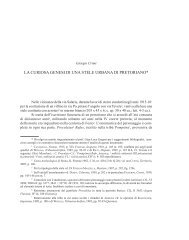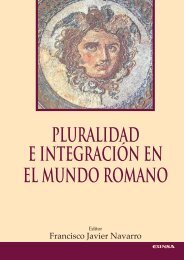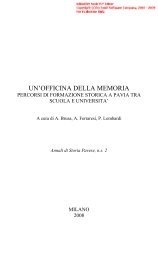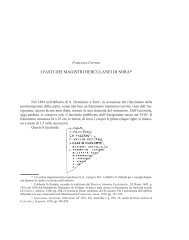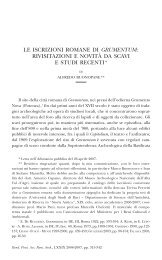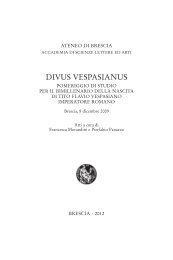There Are No cursus honorum Inscriptions. The Function of the ...
There Are No cursus honorum Inscriptions. The Function of the ...
There Are No cursus honorum Inscriptions. The Function of the ...
Create successful ePaper yourself
Turn your PDF publications into a flip-book with our unique Google optimized e-Paper software.
84 THERE ARE NO CURSUS HONORUM INSCRIPTIONS<br />
already existed in <strong>the</strong> building inscription for <strong>the</strong> baths in Barcino mentioned before, but<br />
since that inscription had been erected he had made tremendous progress and reached <strong>the</strong><br />
highest position in <strong>the</strong> senatorial hierarchy, <strong>the</strong> proconsulate <strong>of</strong> Africa, as had his fa<strong>the</strong>r<br />
before him. <strong>The</strong> well-informed citizens <strong>of</strong> <strong>the</strong> city <strong>of</strong> Barcino knew <strong>of</strong> course just how<br />
far <strong>the</strong>ir most prominent citizen had risen in <strong>the</strong> imperial hierarchy. Never<strong>the</strong>less, <strong>the</strong><br />
long climb to <strong>the</strong> top had to be recorded in detail. We may safely assume that this<br />
detailed enumeration received <strong>the</strong> imprimatur <strong>of</strong> <strong>the</strong> honouree, but we can also prove that<br />
this was <strong>the</strong> case on <strong>the</strong> basis <strong>of</strong> a text from sou<strong>the</strong>rn Etruria.<br />
Minicius Natalis <strong>the</strong> son had ties <strong>the</strong>re; probably <strong>the</strong> family had bought land in<br />
sou<strong>the</strong>rn Etruria, since, by Trajan’s order, all candidates for senatorial <strong>of</strong>fice had to<br />
invest at least one third <strong>of</strong> <strong>the</strong>ir property in Italian land. Minicius Natalis junior built a<br />
sanctuary for several unidentifiable deities in <strong>the</strong> vicinity <strong>of</strong> today’s Viterbo, and had a<br />
dedicatory inscription engraved <strong>the</strong>re. <strong>The</strong> names <strong>of</strong> <strong>the</strong> gods appeared in Greek. In<br />
addition to <strong>the</strong> gods’ names, this long inscription mentioned <strong>the</strong> name <strong>of</strong> <strong>the</strong> senatorial<br />
dedicator and his entire <strong>cursus</strong> <strong>honorum</strong>, from <strong>the</strong> first <strong>of</strong>fice to <strong>the</strong> last, as proconsul <strong>of</strong><br />
Africa. 18 It is clear that Minicius Natalis junior himself was responsible for <strong>the</strong><br />
dedication, since after <strong>the</strong> gods’ names in <strong>the</strong> dative case, his name and career appear in<br />
<strong>the</strong> nominative case. But we can go fur<strong>the</strong>r and prove that <strong>the</strong> text was authored by him<br />
in this form and in this formulation, since it contains a distinctive and almost<br />
idiosyncratic element, which does not recur in a stereotypical <strong>cursus</strong> <strong>honorum</strong>. One <strong>of</strong><br />
<strong>the</strong> <strong>of</strong>fices in <strong>the</strong> inscription from Viterbo was described as follows: [quaest(or)<br />
candid(atus) Aug(usti) et eodem tempore leg(atus) pat]ris sui [pr]ovinc(iae) [Africae],<br />
i.e. ‘quaestor as candidate <strong>of</strong> <strong>the</strong> emperor and at <strong>the</strong> same time legate <strong>of</strong> his own fa<strong>the</strong>r in<br />
Africa’. And if this is not enough to prove <strong>the</strong> personal touch, let me add that this is by<br />
no means <strong>the</strong> only text where we find this formulation: this element recurs in almost<br />
identical phrasing in all <strong>the</strong> inscriptions that mention <strong>the</strong> <strong>cursus</strong> <strong>honorum</strong> <strong>of</strong> this senator.<br />
I note first <strong>the</strong> four inscriptions from his home town Barcino. <strong>The</strong> building inscription<br />
from <strong>the</strong> baths, previously cited, was <strong>the</strong> earliest to contain this element:<br />
q(uaestori) Aug(usti) et [eodem tempore leg(ato) p]r(o) pr(aetore) patris provinc(iae)<br />
Africae. 19<br />
<strong>The</strong> dedication by Carthage under <strong>the</strong> quadriga for <strong>the</strong> senator in Barcino featured<br />
almost identical wording:<br />
[quaestori candi]dato Im[p(eratoris) et eodem temp(ore) leg(ato) pr(o) pr(aetore) patris<br />
provinciae Africae diocese]os Cart[haginiens(is) --- colon]ia [Iul]ia Car[thago ex<br />
Africa]. 20<br />
18 CIL XI 3002 = IG XIV 2260 (Viterbo): [---]bai [---]riw [---]mw kai[---]" qeoi'".<br />
[L. Minicius L. f. Natalis cos. aug. pr]ocos. prov. A[fricae leg.] Aug. pr. pr. prov. Moesiae<br />
in[ferioris curat. oper. publicor. et ae]dium sacrar[um curator] viae Flaminiae [praef.<br />
alimentor. leg. Aug. leg. VI] Vic[t]r. Britannia [praetor trib. pleb. candidatus] [quaest(or)<br />
candid(atus) Aug. et eodem tempore leg. pat]ris sui [pr]ovinc. [Africae trib. mil. leg. I Adiut.<br />
p. f. item leg. XIII Gem.] Mart(iae) Vi[ctr. IIIvir monet. a. a. a. f. f.].<br />
19 CIL II 4509 = CIL II 6145 = ILS 1029 = <strong>Inscriptions</strong> Romaines de Catalogne 4, 30<br />
(Barcino).<br />
20 <strong>Inscriptions</strong> Romaines de Catalogne 4, 34 = AE 1998, 804 (Barcino).



